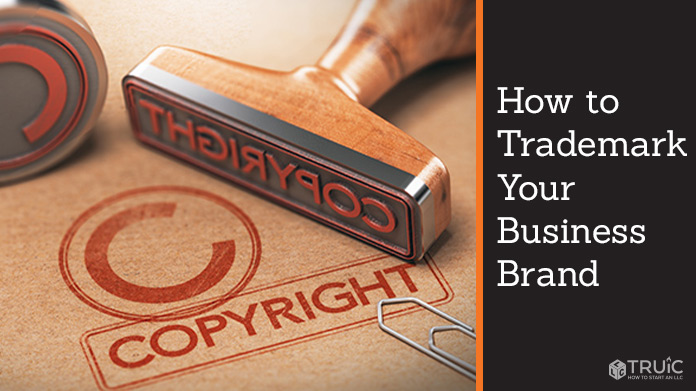How to Trademark Your Business Brand
When starting your new business, you will want your brand to stand out from the competition. Getting a trademark is a great way to protect your business from any naming or branding disputes while ensuring that your business stands out.
However, trademarking your brand is a legal process and can be a bit complicated. In this article, we’ll explain what a trademark is, the differences between trademarks and other intellectual property (IP) protections, whether or not you should get a trademark for your business, and how to register for a trademark if you decide that trademarking your brand is right for you.
Recommended: Use Trademark Engine to search federal databases for direct-hits, prepare and easily file your application with the US Patent & Trademark Office.

What is a Trademark?
A trademark is any word, slogan, symbol, design, or any combination of these that identifies the source of a business’s goods and services and distinguishes them from the goods and services of another party. The main purpose of a trademark is to prevent consumer confusion by ensuring two similar businesses do not operate under the same name or symbol.
Trademarking your business through the US Patent and Trade Office (USPTO) allows you to legally protect your business’s brand. However, it is a legal process, so hiring a private attorney who specializes in trademark law or going through a trademark registration company is highly recommended, but not required.
Differences Between a Trademark, a Patent, and a Copyright
Trademarks, patents, and copyrights are all forms of intellectual property, but they apply in a wide variety of different ways.
- Trademark: Trademarks are designed to differentiate one business from another. They ensure that consumers are never confused about who they are doing business with and that business owners do not face unfair competition from similar companies using the same or similar names or logos to theirs. Trademarks need not be registered with the federal government but may be approved for 10 year periods.
- Patent: A patent is a right granted to an inventor by the federal government that permits the inventor to exclude others from making, selling or using their invention for a period of time. Patents come in three categories: utility patents, design patents, and plant patents. They are generally valid for twenty years.
- Copyright: A copyright is a collection of rights that automatically vest to someone who creates an original work of authorship such as a literary work, song, movie, or software. These rights include the right to reproduce the work, to prepare derivative works, to distribute copies, and to perform and display the work publicly. Works do not need to be registered with the U.S. Copyright Office, but doing so can be beneficial. Copyrights are generally valid for the life of the creator plus seventy years.
The Difference Between a Business Name and a Trademark
Your business name is simply the name you select for your business. The major difference between a business name and a trademark is that trademarks can apply to more than just the name of your company.
While you can register your business name with both your state authorities and the USPTO, your state will not protect your business’s logo, slogan, or other identifying features from being used by others. This protection flows directly from federal trademark laws.
Types of Trademarks
There are four main types of trademarks:
- Trademarks: These marks are used for businesses that deal with goods.
- Service marks: These marks are used for businesses that deal with services.
- Collective marks: These marks are used by members of a collective to indicate membership in the group or to identify and distinguish the products and services of members from non-members.
- Certification marks: These marks are used to show consumers that particular goods or services, or their providers, have met certain standards.
What Can’t Be Trademarked
There are limitations on what the federal government will uphold as a trademark or allow to be registered as one. This includes:
- Generic trademarks: Generic words or phrases commonly used in the course of business cannot be trademarked. If you run a clothing store, you cannot trademark the word “clothes.” Similarly, a fruit stand or smoothie shop would likely not be permitted to trademark the word “apple.” However, since that word is not commonly used in the course of doing business in the tech industry, Apple can hold a trademark to sell phones and computers under that name.
- Existing trademarks: You cannot trademark a word or phrase that is already a registered trademark within the same class of products or services. For example, two soap companies cannot both register the name Dove, but the USPTO does allow both Dove soap and Dove chocolate to hold trademarks on the same word since this is unlikely to create customer confusion.
- Some unregistered trademarks: The federal government generally recognizes trademarks even if they have not been registered. If you attempt to register a trademark that is already in use by another business in your industry or state, your application may be rejected. The determination will be based on whether having two businesses with the same name will cause consumer confusion.
File Your Patent Application
Use a professional service like Trademark Engine to securely file your application with the US Patent and Trademark Office for only $99 + USPTO filing fees.
Should I Get a Trademark?
Like any decision you will have to make as a business owner, choosing whether to trademark your business can be a hard choice to make. Trademarks provide solid protection for your brand and give you the legal rights to protect your brand from infringement. However, trademarks are not necessary for every business owner.
Reasons to Get a Trademark
Trademarking your brand has many advantages for your business. Some of those advantages include:
- Anticybersquatting Consumer Protection Act
This is only available through the USPTO and allows the business owner to sue domain name registrants using identical or confusingly similar trademarks - Universal protection across the US
If you choose to trademark your business, you gain protection for your brand across the United States; however, that is only if you register with the USPTO. If you register your mark with the state, it will only be protected in that state or geographic area. - Counterfeit protection
You are allowed to ask US Customs and Border Protection to automatically confiscate counterfeit import goods. - Can lead to global protection
Having a trademark in the US makes it much easier to have your mark become protected in other countries. - Federal law protection
Any infringement lawsuits will be held in federal court instead of state court. - Allowed to use the ® symbol
An official trademark through the USPTO lets you use the ® symbol with your logo, although it isn’t required to be used with every appearance of your mark. This symbol can only be used once the application process is completed, not during.
Reasons Not to Get a Trademark
Although a trademark does give a lot of protection to your brand, it’s also a long and expensive process. A business owner can still protect their brand even without a trademark.
- Trademarks can be time-consuming
There are some long processes to register your trademark; it can take months to prepare your application and then up to 10 months to process the application. - Trademarks can be expensive
The application fee is nonrefundable and is about $225 plus an additional $400 per class of goods or services. You may also have to hire an attorney to help you properly fill out the application and protect your brand after it’s been trademarked.
Alternatives to Trademarks
Some business owners may choose not to trademark their business and instead choose an easier and cheaper alternative.
- ™ symbol
Anyone can use the ™ symbol with their mark, and it’s commonly used if a business owner cannot register their business. Although it holds little legal power, it may deter people from trying to use your mark. - Common law
The moment your logo is used for labels, packaging, or your product, it is trademarked under common law, even if you never registered your trademark with a government agency. If your business is the first to use a trademark, common law rights preserve your ability to use the trademark in your geographic area. This is protected on the federal level and by states, though some have slightly different variations on the rules.
However, unlike an official federal trademark, it is difficult to protect a common law trademark outside of your specific geographic area. Common law rights are generally hard to enforce because there is no official public record of your trademark or when use began. For that reason, it is highly recommended you officially register your trademark. Common law trademark rights are enforceable in court and before the Trademark Trial and Appeal Board, who you should reach out to if you are facing a dispute. Another good resource is the USPTO. - Register with your state
Every state allows you to trademark your brand, and it is usually cheaper and faster — sometimes as low as $30. You still have to do some work for the application process, but it does offer more protection for your brand. However, that protection doesn’t extend past the state your brand is registered in. If you want to register a trademark in your state, the USPTO website has a link to each states registration website.
How to Get a Trademark
Application Steps
- Before filling in the application, you should do a clearance search on the USPTO database to make sure your name and logo are not already trademarked. Failure to conduct a proper search is one of the key reasons an application is rejected. It’s also recommended to do a state search and a general internet search for common law purposes.
- Once you’ve found a mark devoid of conflict, you can file two types of trademark applications with the USPTO. The TEAS Plus application allows for a less expensive filing fee and a more streamlined process; however, you are required to file a complete initial application. If you can’t file a complete application off the bat, you can opt for TEAS Standard.
- Both the TEAS Plus and TEAS Standard require applicants to answer similar questions about the owner of the mark, entity type, country of citizenship, and more. In the application, you will be required to select your type of mark: standard character, special form, or, in rare cases, sound mark. You need to attach a JPG and description for special form trademarks.
- An important component is filling out the Goods and Services page of the application by accurately identifying what goods and services you are trademarking. Be as specific as possible because the examination of your application is based on this selection.
- You will need to select your filing “basis” (i.e., why you want a trademark). This will most likely be a current use of the mark in commerce or an intent to use it. At this point, you may need to attach a jpg of your goods and services in use.
The USPTO has a step-by-step breakdown of the entire application process online.
Price and Application Length
The cost of the application varies depending on whether you opt for TEAS Plus or TEAS Standard. TEAS Plus costs $225, while TEAS Standard is $275. However, this number can increase depending on how many classes of goods and services you are registering, as well as how many marks.
Once registered, you are responsible for monitoring the progress of your application through the Trademark Status and Document Retrieval (TSDR) system, which should be checked at least every three to six months after the initial filing. If not, you may miss a filing deadline. The USPTO says you should receive an initial response within approximately three months of filing, though the total application process can take much longer.
Common Law Trademark Rights
Before and during the application process, your trademark is protected by common law trademark rights if you are the first person to use the mark. Though this can be upheld in court, it is generally safer to officially register with the USPTO — especially if you plan on expanding your business outside of your state.
Tips for Success
- Weak trademarks vs. strong trademarks: Strong trademarks are those that are legally registerable and federally protectable. It’s imperative to keep in mind the purpose of a trademark: helping consumers identify and differentiate the source of goods and services. Therefore, you should stay away from names or logos that look/sound/have similar meanings or commercial impressions to other goods and services in the same industry (or are very well-known).
More specifically, the strongest trademarks are fanciful (invented) or arbitrary (no association with the goods). For example, naming a tire company “bananas.” Suggestive marks — suggesting qualities about the goods — can also be strong too. The weakest marks are generic words or descriptive terms, like “Bicycle” for bicycles or “Creamy” for yogurt. - The best time to register: Though there is no “right time” for trademarking your company, it’s generally recommended to trademark before you incorporate. That way, you can avoid the risk of trademark infringement. If you haven’t begun selling your product yet, you can wait a little longer before trademarking, but if you’ve already begun selling the product under that name and you know you want to trademark, there’s no point in waiting. After all, trademark rights are determined by who has trademark priority.
- Additional help: Though USPTO staff can provide information about the application process, they cannot give legal advice or give out forms and generally recommend you hire an attorney specializing in trademark law. If you want to complete the application on your own, the USPTO website has plenty of helpful resources explaining what to expect throughout the process.
What to Expect After You Trademark Your Business
Responsibilities
Though you may breathe a sigh of relief once your trademark has been approved, the journey does not end there. You are responsible for protecting your trademark because the USPTO does not “police” the use of marks. What this means is that you are responsible for ensuring no other party receives federal registration for a mark similar or identical to yours for related goods or services. If you do notice an issue, it’s your responsibility to bring legal action against the party attempting to infringe upon your trademark.
Maintaining your trademark
Though trademark rights can last forever, you must continue to use your trademark in commerce and continue to file the required maintenance documents at regular intervals to keep your federal trademark alive. The first maintenance document must be filed between the fifth and sixth years after registration. The remaining documents must be filed between the ninth and tenth years after registration, and then every ten years after that. Failure to file these documents ends in the cancellation or loss of your federal registration.
The statement of use you have to file between the fifth and sixth year costs $200 per class of goods or services. Then it costs $425 to file the statement of use and declaration every ninth-to-tenth year per class of goods or services.
FAQ
What is a trademark?
A trademark is a word, phrase, slogan, symbol, or design (or a combination thereof) that identifies the source of goods and distinguishes them from the goods of another party.
What is a service mark?
A service mark serves the same purpose as a trademark but is different because it identifies the source of services, as opposed to goods. Though the two differ, you can informally refer to a service mark as a trademark.
What is the difference between ™, SM, and ®?
- A ™ symbol stands for “trademark” and is used in conjunction with marks that identify products. You do not have to officially register with the USPTO to use this symbol, and many companies use it before and during the application process.
- An SM symbol stands for “service mark” and is used in conjunction with marks that identify services. You do not have to officially register with the USPTO to use this symbol, and many companies use it before and during the application process.
- An ® indicates the word, phrase, or logo that is officially registered with the USPTO. It can only be used for registered trademarks by the owner or licensee.
What is the difference between a trademark, a patent, and a copyright?
- A trademark is a brand used on goods and services.
- A patent typically protects inventions, like new engines or solar panels.
- A copyright typically protects original artistic and literary works like songs, movies, and books.
Are you able to trademark a name and logo together, and should you do that?
You can file both together, but if you do that, you must always use that exact combination on your products and services, which can be limiting. Therefore, it is recommended that you apply separately to trademark names and logos in case you ever want to use one without the other (which you probably will).
Do I need an attorney when registering for a trademark?
You only need an attorney when registering for a trademark if your address is outside the United States. In that case, you must have a US-licensed attorney representing you.
What do I do if my trademark application is refused?
The USPTO refuses registration of trademarks on numerous grounds. The most common are the following:
- Likelihood of confusion (i.e., your trademark is similar in sound, appearance, or meaning to an already registered mark).
- The mark is merely descriptive or deceptively misdescriptive.
- The mark is primarily geographically descriptive or primarily geographically deceptively misdescriptive.
- The mark is primarily a surname.
- The mark is overly ornamental.
You can read more about the reasons why a trademark would be rejected on the USPTO website. Most of these issues are easy to avoid, but if your application is rejected because of a conflicting mark — the most common reason — you can submit arguments to the trademark examiner or get the owner of the conflicting trademark to sign a consent agreement (a coexistence agreement). Alternatively, you can continue using the trademark; however, this could put you at risk of a copyright infringement lawsuit.


